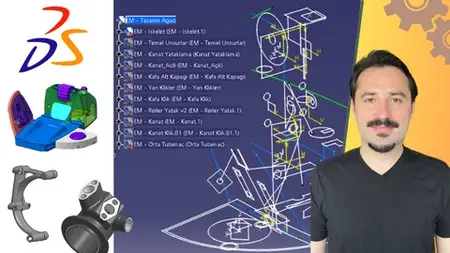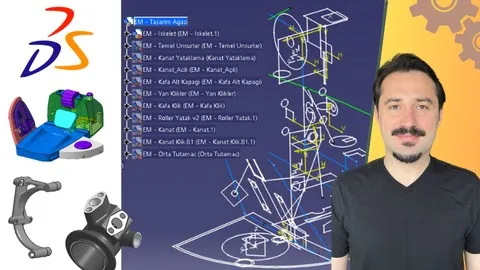Parametric Design With Catia, Theory And Practice.
Published 11/2024
MP4 | Video: h264, 1920x1080 | Audio: AAC, 44.1 KHz
Language: English | Size: 16.05 GB | Duration: 10h 24m
Published 11/2024
MP4 | Video: h264, 1920x1080 | Audio: AAC, 44.1 KHz
Language: English | Size: 16.05 GB | Duration: 10h 24m
Make a difference in Aviation, Defence Industry, Automotive and many other sectors, improve your 3d design technique.
What you'll learn
You will have knowledge about the most up-to-date modelling techniques used by Aerospace, Defence Industry and Automotive
You will get an easier introduction to part design from zero and reach the final design on parametric basics,
You will take your CATIA knowledge to a professional level, you will improve your modelling technique
You will add a feature that will add value to your CV, you will gain an advantage in entering the sector
You will have information about all the details of Parametric design with CATIA,
You will learn volume based modelling technique with parametric design,
You will be able to minimise, or even eliminate, design-induced errors in production,
You will be able to perform the part revisions you encounter during the transition to Prototype and Mass Production in a much faster and controlled manner,
You will be able to prepare your own designs according to parametric modelling principles
Requirements
Knowledge of 3D modelling with CATIA is required.
I recommend that you know how to use the CATIA programme, even at a basic level.
Description
You will take our CATIA knowledge and experience one level further! A training where you will make a difference with your modelling ability is waiting for you.Make a Difference in Aviation, Defence and Automotive Sector with CATIA Parametric Design Training!In this training specially designed for engineers who want to improve their modelling skills and accelerate their career, you will learn all the subtleties of parametric design. Learn to make faster, more reliable and more creative designs using the most up-to-date methods of the industry. With parametric design modelling, one of the most valid modelling methods in Aerospace, Defence Industry and Automotive;If you are an industry professional; you will improve your experience, you will be able to manage all design processes from new design to existing revisions more quickly, safely and smoothly.If you are a newly graduated engineer; you will add another important skill to your CV and you will make a difference in job applications in the sectors I mentioned.We will learn the importance and advantages of the Parametric Design technique from the theory and develop your modelling technique together by learning step by step from scratch in the application section.If you are making designs with traditional modelling technique in your company, you will both improve the technical capabilities of the company and achieve serious savings with the advantages of parametric design and especially the savings it provides in development processes. You will multiply your speed in all revision and new product development processes. With the advantages of parametric design in production, you will minimise design-related problems in production.Parametric design is not only a modelling technique, but also a powerful tool that transforms your design processes. Thanks to this technology, you can make your designs faster and more flexible, minimise errors and reduce your production costs. Parametric design will allow you to make a big leap in both your career and your company. While strengthening your CV as a newly graduated engineer , you will increase the competitiveness of your company as an experienced engineer.You will make a difference in both career and sectoral sense thanks to many more advantages as I mentioned above and shared below.The main advantages of 3D modelling with Parametric Design can be found below:Fully consistent top-down design, (Top-Down Design)Simultaneous design of sub-assemblies while creating the main structure,Critical dimensions for the master part are changed quickly and the affected parts update themselves accordingly,Quickly transferring the necessary changes to the design so that the existing design can be used in other applications,Quickly transferring the feedback from the analyses to the design,Ease of creating a separate analysis data,Ensuring full control over the model, (Geometric and Engineering Constraints)Changes made in the design are automatically updated,Easier to see and understand how the model will react after a change,Easy definition and automatic creation of part families,Perfect integration with production processes, significant reduction in production time,To be able to create a user interface suitable for software integration,Ability to prepare designs suitable for different manufacturing methods with the same information data.
Overview
Section 1: Parametrik Tasarım'a Giriş
Lecture 1 Introduction to Parametric Design, Presentation Flow
Lecture 2 What is Parametric Design
Lecture 3 Where to Use Parametric Design
Lecture 4 Why Does Design Change ?
Lecture 5 3D Modelling Technique
Lecture 6 Tools for Parametric Design
Lecture 7 Advantages and Disadvantages of Parametric Design
Lecture 8 Parameters in Parametric Design
Lecture 9 Parameters on Sample Parts, Conclusion
Section 2: Parametrik Tasarım'da Kavramlar
Lecture 10 Section-2 Topics and Titles
Lecture 11 What is the Design Tree Structure?
Lecture 12 What is Skeleton Structure
Lecture 13 What is the Basic Element Structure
Lecture 14 What is Outer Structure
Lecture 15 What is Internal Structure, Core
Lecture 16 What is Analysis Data
Lecture 17 What is a Raw Part
Lecture 18 What is Machining Structure
Lecture 19 Final Part
Lecture 20 Case Studies in Parametric Design
Lecture 21 CATIA Settings for Parametric Design
Section 3: Parametrik Tasarım Uygulaması
Lecture 22 Defining the Design Problem
Lecture 23 Let's Start with Skeleton Structure, S1
Lecture 24 Skeleton Structure, S2
Lecture 25 Skeleton Structure, S3
Lecture 26 Skeleton Structure, S4
Lecture 27 Skeleton Structure, S5
Lecture 28 Skeleton Structure, S6
Lecture 29 We continue with Basic Structure, S1
Lecture 30 Basic Structure, S2
Lecture 31 Basic Structure, S3
Lecture 32 Basic Structure; Manufacturing, S4
Lecture 33 Outer Structure is revealing, S1
Lecture 34 Outer Structure, S2
Lecture 35 Outer Structure, S3
Lecture 36 Outer Structure, S4 - Revisions
Lecture 37 Inner Structure, Core
Lecture 38 This is Raw Part
Lecture 39 Analysis Data
Lecture 40 Machining Structure, S1
Lecture 41 Machining Structure, S2
Lecture 42 At last, Final Data !
Lecture 43 Let's run Design Tree, some Revisions came to design. S1
Lecture 44 Revisions, S2
Lecture 45 Conclusion
It appeals to all R&D, P&D and Design Engineers who have gained experience in the sector.,It appeals to all R&D, P&D and Design Engineers who have gained experience in the sector.,Those who want to learn how to design parts from scratch,,Those who do not know where to start designing and how to proceed,



